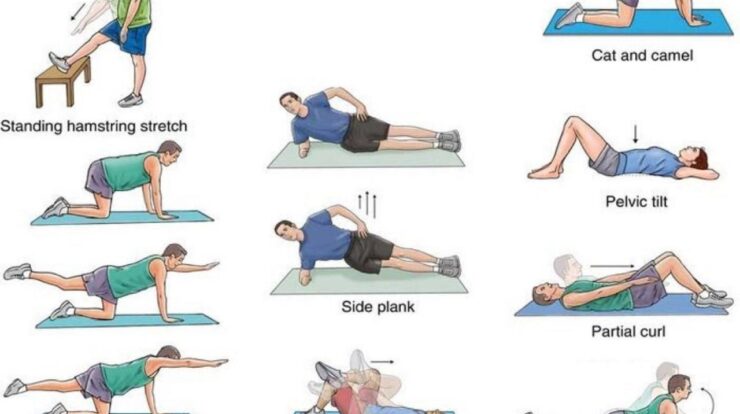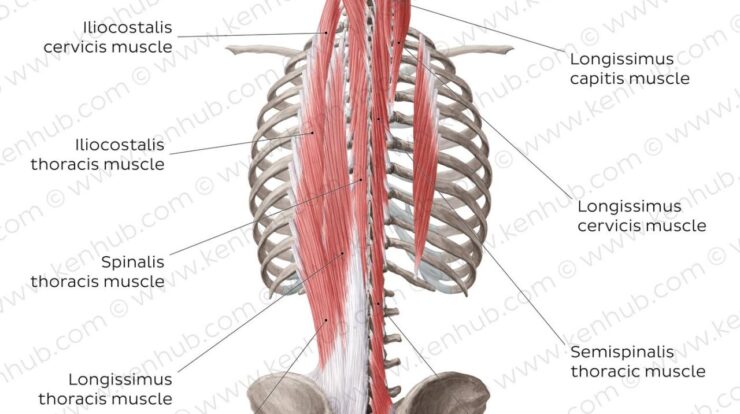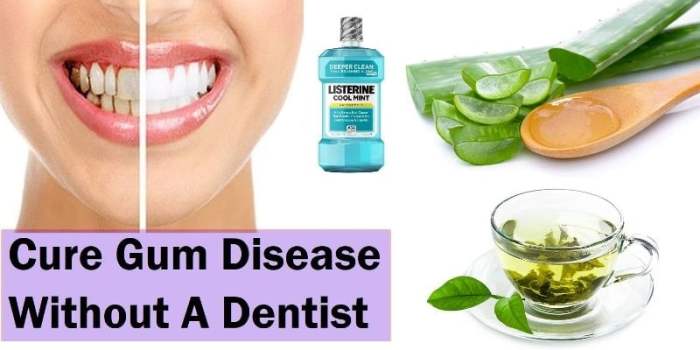
Tired of pricey dental visits? Discover how to cure gum disease without a dentist! From natural remedies to lifestyle changes, we’ve got you covered. Say goodbye to bleeding gums and hello to a healthy smile.
Let’s dive into the world of DIY gum disease solutions and empower you with the knowledge to conquer this common ailment.
Home Remedies and Natural Treatments
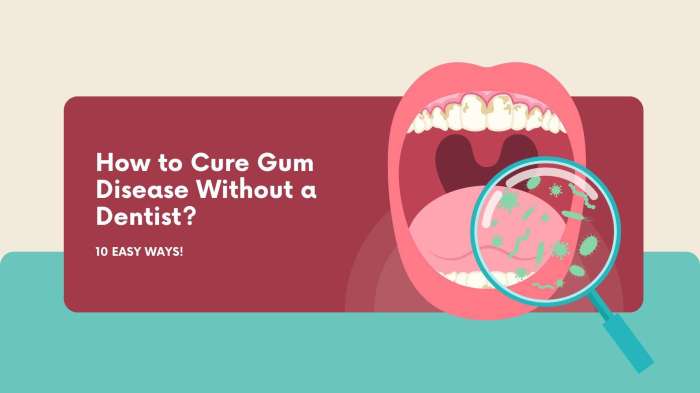
Gum disease, also known as periodontal disease, is a common condition that affects the gums and supporting structures of the teeth. It can cause a range of symptoms, including bleeding, swelling, and pain. In severe cases, gum disease can lead to tooth loss.
While there are a number of effective treatments for gum disease, some people prefer to try home remedies and natural treatments. These treatments can be helpful in reducing symptoms and improving gum health, but they are not a substitute for professional dental care.
Salt Water Rinses
Salt water rinses are a simple and effective way to reduce inflammation and kill bacteria in the mouth. To make a salt water rinse, dissolve 1/2 teaspoon of salt in 8 ounces of warm water. Rinse your mouth with the solution for 30 seconds, then spit it out.
Repeat several times a day.
Oil Pulling
Oil pulling is an ancient Ayurvedic practice that involves swishing oil around in the mouth for 15-20 minutes. This helps to remove bacteria and toxins from the mouth and teeth. Coconut oil is a popular choice for oil pulling, but you can also use sesame oil or sunflower oil.
To oil pull, put 1 tablespoon of oil in your mouth and swish it around for 15-20 minutes. Be sure to spit out the oil when you’re finished. Do not swallow it.
Table of Natural Remedies for Gum Disease
| Remedy | Ingredients | Method of Use ||—|—|—|| Salt water rinse | 1/2 teaspoon salt | Dissolve in 8 ounces of warm water and rinse mouth for 30 seconds || Oil pulling | 1 tablespoon coconut oil | Swish around in mouth for 15-20 minutes || Tea tree oil | 2-3 drops | Dilute in 8 ounces of water and rinse mouth for 30 seconds || Myrrh | 1 teaspoon | Dissolve in 8 ounces of water and rinse mouth for 30 seconds || Aloe vera | 1/2 cup | Apply to gums and leave on for 30 minutes || Green tea | 1 cup | Drink 2-3 cups per day |
Lifestyle Changes
Lifestyle changes play a significant role in preventing and managing gum disease. This includes quitting smoking, maintaining good oral hygiene, and adopting proper brushing and flossing techniques.
Smoking Cessation
Smoking is a major risk factor for gum disease. Chemicals in cigarettes damage the immune system and reduce blood flow to the gums, making them more susceptible to infection.
Maintaining Good Oral Hygiene
Regular brushing and flossing removes plaque and bacteria that can cause gum disease. It’s important to brush twice a day with a fluoride toothpaste and floss at least once a day.
Proper Brushing and Flossing Techniques, How to cure gum disease without a dentist
- Brushing:Hold the toothbrush at a 45-degree angle to the gum line and use gentle circular motions. Brush for at least two minutes, covering all surfaces of the teeth.
- Flossing:Wrap the floss around your middle fingers and gently slide it between each tooth. Use an up-and-down motion to remove plaque and bacteria.
Diet and Nutrition
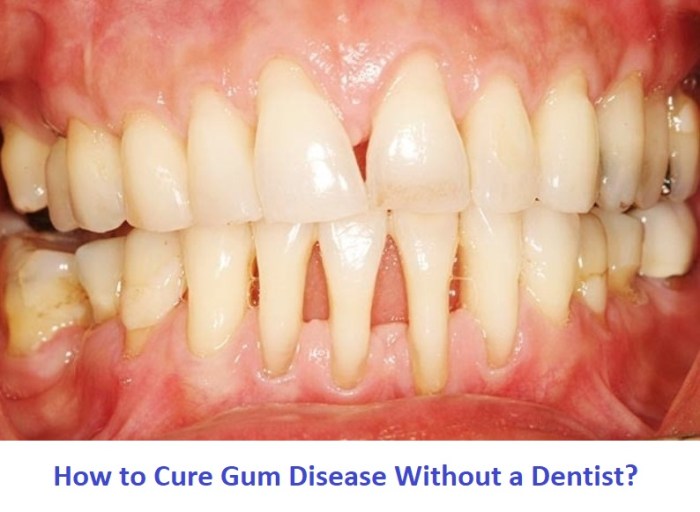
Diet and nutrition play a crucial role in maintaining gum health. Consuming a balanced diet rich in essential vitamins and minerals is vital for supporting healthy gums.
Vitamin C
Vitamin C is a powerful antioxidant that supports collagen production, a protein that provides structure and strength to gums. Collagen is essential for maintaining healthy gums and preventing gum disease.
Foods Rich in Vitamin C
- Citrus fruits (oranges, grapefruits, lemons)
- Berries (strawberries, blueberries, raspberries)
- Kiwi
- Broccoli
- Spinach
Meal Plan for Gum Health
To promote gum health, consider incorporating the following foods into your daily diet:
- Breakfast:Oatmeal with berries and nuts
- Lunch:Salad with grilled chicken, spinach, and citrus segments
- Dinner:Salmon with roasted broccoli and sweet potato
- Snacks:Apple slices with peanut butter, or celery sticks with hummus
Alternative Therapies
In addition to home remedies, natural treatments, lifestyle changes, and diet modifications, several alternative therapies may provide complementary support in managing gum disease. These therapies aim to reduce inflammation, promote tissue regeneration, and improve overall oral health.
Acupuncture
Acupuncture involves the insertion of thin needles into specific points on the body. For gum disease, acupuncture points located around the mouth and face are targeted. It is believed that stimulating these points can regulate the body’s immune response, reduce inflammation, and promote blood flow to the gums.
Laser Therapy
Laser therapy utilizes low-level lasers to deliver energy to the affected gum tissue. This energy stimulates cellular activity, enhances tissue regeneration, and reduces inflammation. Laser therapy can be particularly effective in treating periodontal pockets, where bacteria accumulate and cause tissue damage.
Table: Summary of Alternative Therapies for Gum Disease
| Therapy | Mechanism of Action | Potential Risks |
|---|---|---|
| Acupuncture | Regulates immune response, reduces inflammation, promotes blood flow | Minor discomfort at insertion points |
| Laser Therapy | Stimulates cellular activity, enhances tissue regeneration, reduces inflammation | Potential for burns or tissue damage if not administered correctly |
Dental Procedures: How To Cure Gum Disease Without A Dentist

Gum disease is a common condition that can lead to serious health problems if left untreated. While there are a number of home remedies and lifestyle changes that can help to improve gum health, in some cases, dental procedures may be necessary to treat gum disease effectively.
Types of Dental Procedures for Gum Disease
There are a variety of dental procedures that can be used to treat gum disease, depending on the severity of the condition. Some of the most common procedures include:
- Scaling and root planing: This is a non-surgical procedure that involves removing plaque and tartar from the teeth and roots. It is typically the first step in treating gum disease.
- Gum surgery: This is a surgical procedure that involves removing diseased gum tissue and bone. It may be necessary to treat severe gum disease or to correct gum recession.
- Bone grafting: This is a surgical procedure that involves placing bone material into the jaw to support the teeth. It may be necessary to treat severe gum disease that has caused bone loss.
- Tissue regeneration: This is a surgical procedure that involves placing a material into the gums to encourage the growth of new tissue. It may be necessary to treat severe gum disease that has caused tissue loss.
The cost, benefits, and risks of each of these procedures vary. The following table provides a general overview:
| Procedure | Cost | Benefits | Risks |
|---|---|---|---|
| Scaling and root planing | $100-$500 | Non-surgical, relatively inexpensive, can improve gum health | May cause some discomfort, may not be effective for severe gum disease |
| Gum surgery | $500-$2,000 | Can treat severe gum disease, can improve gum health and appearance | Surgical procedure, may require anesthesia, may cause some pain and discomfort |
| Bone grafting | $1,000-$3,000 | Can treat severe gum disease that has caused bone loss, can improve gum health and support the teeth | Surgical procedure, may require anesthesia, may cause some pain and discomfort |
| Tissue regeneration | $1,000-$3,000 | Can treat severe gum disease that has caused tissue loss, can improve gum health and appearance | Surgical procedure, may require anesthesia, may cause some pain and discomfort |
It is important to note that the cost of dental procedures can vary depending on a number of factors, such as the severity of the gum disease, the location of the dental practice, and the experience of the dentist. It is also important to discuss the risks and benefits of each procedure with your dentist before making a decision.
Regular Dental Checkups
Regular dental checkups are essential for maintaining good oral health and preventing gum disease. During a dental checkup, your dentist will examine your teeth and gums for signs of gum disease. They will also clean your teeth and remove plaque and tartar.
If your dentist detects any signs of gum disease, they will recommend the appropriate treatment.
Early detection and treatment of gum disease is essential for preventing serious health problems. By following a good oral hygiene routine and getting regular dental checkups, you can help to keep your gums healthy and your smile bright.
Wrap-Up
With a little effort and these effective strategies, you can bid farewell to gum disease and embrace a radiant smile. Remember, prevention is key, so make these habits a part of your daily routine. Your gums will thank you for it!
Essential FAQs
Can I cure gum disease without visiting a dentist?
Yes, while some cases require professional attention, many mild to moderate cases can be managed at home with proper care.
How long does it take to cure gum disease naturally?
Results vary depending on the severity of the condition and consistency of treatment. With dedication, you can expect noticeable improvements within a few weeks.
Are there any risks associated with home remedies for gum disease?
While most natural remedies are generally safe, it’s always wise to consult with a healthcare professional before using any new treatments, especially if you have underlying health conditions.
